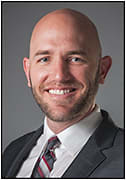Industry Insider is a timely chat with an ophthalmic industry thought leader.
Equinox was founded in 2014 by John Berdahl, MD, to find glaucoma treatments based on the concept of “multi-pressure glaucoma management,” or MGM. Equinox’s Mercury Multi-Pressure Dial (MPD) uses MGM to treat the unmet needs of glaucoma patients with severe glaucoma or normal-tension glaucoma (NTG).
Matt Larson serves as Equinox’s global president and COO. Before joining Equinox, Mr. Larson spent more than a decade working for AcuFocus, primarily in positions for global commercialization.
Ophthalmology Management: What can you tell us about MGM, and why it is an effective way to treat glaucoma?
Matt Larson: Originally, glaucoma was thought of as a “one pressure” disease, that pressure being IOP. Our founder, Dr. Berdahl, conducted extensive research and found it is a multi-pressure disease; not just IOP but also intracranial pressure (ICP). Some research suggests that blood pressure plays a role, as well. This is why, for instance, two people can have high IOP but not have the same damage from glaucoma.
Our device, the MPD, treats patients using an additional pressure: atmospheric pressure. While it can help any glaucoma patient, it’s especially helpful for patients with NTG or severe glaucoma. They’ve likely tried the drops, surgeries and laser options, and while those are great for many patients, they don’t work as well when you have a lower baseline pressure. We believe the MPD is a great solution for this underserved population, because it is effective no matter the eye’s internal pressure.
NTG is a big category, as well — it’s estimated that 30% of the U.S. glaucoma population has NTG, and it’s even bigger in Asia. In nations like Japan, China and Korea, 80% to 90% of the glaucoma population has NTG.
OM: How does the MPD work?
ML: MPD is a pair of goggles connected to a light-weight programmable device with pressure settings set to a physician’s prescription. Once you reach a desired seal around the orbital plate, it will administer negative pressure in front of each eye; by lowering that, we can predictably lower a patient’s IOP.
While the final instructions may be altered based on our study data, the intention is for patients to wear the goggles at night. Ideally, this would be done while the patient is sleeping, both because it is a convenient time to leave the MPD on and because IOP drastically increases at night, and we want to provide IOP control during this vulnerable period.
OM: Are there any unique challenges in developing this new treatment during a pandemic?
ML: We’ve had our challenges, like everyone, but I think we’ve gotten lucky in some areas. For example, we were able to finish our FDA trial in early March, right before much of the country locked down. After that, we started the paperwork phase and didn’t suffer any real delays there. I am proud to say the team has done a fantastic job of pivoting in a virtual setting, including clinical training for our study sites.
As the pandemic has continued, though, the MPD can present an option for patients who are not comfortable going into a doctor’s clinic. Once the MPD is available and prescribed to a patient, we can wirelessly monitor their usage of the device. This information can be shared with their doctor.
OM: How has your previous experience in global commercialization roles prepared you for your job at Equinox?
ML: I was fortunate during my time at AcuFocus to be involved in several products from early development to commercial launch, which has helped me know what steps we need to get this device to market. I also have a lot of experience in Asia, where there is a great need for NTG treatments. I’m excited to be able to put my Asia experience to work, to hopefully help us expand beyond the U.S. OM









